Rose of Sharon [Starburst Chiffon] Hibiscus syriacus Starburst Chiffon = 'Rwoods6' (Chiffon Series)
![rose of Sharon [Starburst Chiffon]](/_next/image?url=https%3A%2F%2Fplants-admin.emdemapps.com%2Fimages%2Fplants%2F%2Fimages%2F604b64297b014.png&w=3840&q=75)
ABOUT
an upright shrub up to 1.8m high, with deciduous, three-lobed, green leaves, and semi-double flowers, up to 10cm across, of pale pink petals, the outer petals with dark pink veins, from late summer to mid-autumn
About this plant
 Names
NamesFamily
Malvaceae
Synonyms
Rose Of Sharon, Shrub Althea, Syrian Ketmia, Rose Mallow
Common names
Hibiscus syriacus Starburst Chiffon = 'Rwoods6' (Chiffon Series).
 Characteristics
CharacteristicsLife cycle
Perennials
Foliage type
Deciduous
Color of leaves
Green
Flower color
Pink
Height
8-12 feet (2.4-3.7 meters)
Spread
6-10 feet (1.8-3 meters)
Plant type
Shrub
Hardiness zones
5
Native area
Asia
Benefits
 General Benefits
General Benefits- Attractive Blossoms - The Starburst Chiffon Hibiscus features large, double blooms with a distinctive pink and white star pattern that add visual interest and beauty to any garden space.
- Long Blooming Period - This variety has a longer flowering season compared to many other shrubs, providing colorful displays from mid-summer to fall.
- Drought Tolerance - Once established, the Starburst Chiffon Hibiscus is relatively drought-tolerant, making it suitable for gardens in drier climates or for gardeners seeking low-water plants.
- Wildlife Attraction - The showy flowers of the hibiscus attract pollinators such as bees, butterflies, and hummingbirds, supporting local ecosystems and biodiversity.
- Low Maintenance - It requires minimal care once established, needing only occasional pruning and feeding to keep it healthy and flourishing.
- Cold Hardy - The plant is reasonably resistant to colder temperatures and can survive in USDA hardiness zones 5 through 8, making it a viable option for many temperate gardens.
- Adaptable - It can adapt to a range of soil types, although it prefers well-drained, fertile soils, making it versatile for different garden settings.
- Privacy Screening - With its dense foliage and upright growth habit, the Starburst Chiffon Hibiscus can be used as an ornamental screen or as part of a hedgerow, providing privacy and reducing noise.
- Architectural Interest - Its upright, vase-shaped growth habit can add structural interest to garden designs and can be used to create focal points in landscape arrangements.
- Container Gardening - Suitable for growing in large pots, the Starburst Chiffon Hibiscus can be utilized for patio gardens, balconies, or other areas where planting in the ground is not an option.
 Medical Properties
Medical PropertiesThis plant is not used for medical purposes.
 Air-purifying Qualities
Air-purifying QualitiesThis plant is not specifically known for air purifying qualities.
 Other Uses
Other Uses- Creating natural dyes: The petals of the Rose of Sharon contain natural pigments that can be used to make fabric dyes in various shades of pink and mauve.
- Edible flower garnishes: The flowers are not only ornamental but also edible, adding a burst of color to salads and desserts.
- Landscaping for noise reduction: When Rose of Sharon hedges are planted in dense rows, they can help dampen traffic noise and create a quieter outdoor environment.
- Attracting pollinators to vegetable gardens: Planting Rose of Sharon near vegetable gardens can attract bees and butterflies, which are essential for pollinating many vegetables and fruits.
- Paper making: The fibrous stems of Rose of Sharon can be used as a material in the traditional paper-making process, producing a distinctively textured paper.
- Education and art projects: The complex structure of the Rose of Sharon flower is used by educators to teach botanical science and by artists as a subject for botanical illustration.
- Photography: The distinctive blooms of Rose of Sharon make it a popular subject for photographers, especially those specializing in macro flower photography.
- Privacy screening: Due to its dense foliage and tall growth, Rose of Sharon can be used to create living privacy screens in gardens and yards.
- Erosion control: With its root system, Rose of Sharon can be effective in stabilization of soil on slopes, helping to prevent erosion.
- Supporting local wildlife: Rose of Sharon is known to provide nectar for hummingbirds and other local wildlife, contributing to biodiversity in the garden.
Interesting Facts
 Feng Shui
Feng ShuiThe Rose of Sharon is not used in Feng Shui practice.
 Zodiac Sign Compitability
Zodiac Sign CompitabilityThe Rose of Sharon is not used in astrology practice.
 Plant Symbolism
Plant Symbolism- Rare Beauty: The Hibiscus syriacus Starburst Chiffon, with its distinctive double-flowered blooms, symbolizes unique and exquisite beauty.
- Feminine Energy: Often associated with femininity due to its delicate and soft petals, the Rose of Sharon represents a graceful and gentle energy.
- Ephemeral Nature: As the flowers of the Rose of Sharon only last for a short time, they remind us of the fleeting nature of life and beauty.
- Inner Strength: Despite its delicate appearance, the Rose of Sharon is known for its resilience and ability to withstand harsh conditions, symbolizing inner strength and perseverance.
- Renewal and Rebirth: The plant's cycle of blooming anew each year can symbolize renewal, fresh beginnings, and the rejuvenation of the spirit.
 Water
WaterThe Rose of Sharon should be watered thoroughly, ensuring that the soil is moist but not waterlogged. During the growing season, water the plant deeply once a week, providing about 1 to 1.5 gallons of water each time, depending on the size of the plant and soil conditions. If the weather is particularly hot or dry, check the soil more frequently and water as needed to keep the soil consistently damp. During the winter, reduce watering since the plant is dormant and the need for moisture lessens.
 Light
LightThe Rose of Sharon thrives in full sun to partial shade, meaning it ideally requires at least 6 hours of direct sunlight each day. The best spot for the plant is in a location where it can receive unfiltered sunlight for the majority of the day, but some afternoon shade can be beneficial in hotter climates to protect the plant from excessive heat.
 Temperature
TemperatureThe Rose of Sharon is hardy in a range of temperatures, capable of withstanding winter cold down to 20 degrees Fahrenheit but preferring the warmer growing conditions found between 60 and 90 degrees Fahrenheit. They should not be exposed to temperatures below 20 degrees Fahrenheit to prevent cold damage.
 Pruning
PruningThe Rose of Sharon should be pruned in late winter or early spring before new growth starts. Pruning promotes better flowering, removes dead or damaged branches, and helps maintain a desired shape. Thin out crowded branches and trim back last year's growth to encourage the development of new flower buds.
 Cleaning
CleaningAs needed
 Soil
SoilThe best soil mix for Rose of Sharon is well-draining with generous organic material, such as compost or peat moss, to retain moisture. The ideal soil pH is slightly acidic to neutral, ranging from 6.0 to 7.5.
 Repotting
RepottingRose of Sharon is typically planted in-ground and does not require frequent repotting. If grown in containers, repot every 2-3 years or when the plant becomes root-bound.
 Humidity & Misting
Humidity & MistingRose of Sharon prefers moderate humidity conditions but is quite adaptable and can tolerate both high and low humidity levels without special care.
 Suitable locations
Suitable locationsIndoor
Ensure bright indirect light, well-draining soil, and regular watering.
Outdoor
Choose sunny location, plant in fertile, well-drained soil, and water moderately.
Hardiness zone
5-9 USDA
 Life cycle
Life cycleThe Hibiscus syriacus 'Starburst Chiffon', commonly known as Rose of Sharon, begins its life as a seed, which after experiencing a period of dormancy, germinates in warm, moist soil typically in spring. Seedlings emerge and establish a root system, followed by the development of foliage; young plants may take several years to reach maturity. The mature Rose of Sharon is a deciduous shrub that blooms in late summer, producing large, ruffled flowers with a burst of color that attract pollinators. After pollination, the plant sets seeds in capsules that, once mature, open to release seeds for dispersal, completing the reproductive cycle. During autumn, the Rose of Sharon enters a dormant phase, shedding its leaves in response to cooler temperatures and reduced daylight. Each year the cycle repeats, with the shrub growing larger and producing more blooms as it ages.
 Propogation
PropogationPropogation time
Late Spring to Early Summer
The most popular method of propagating Hibiscus syriacus 'Starburst Chiffon' is through softwood cuttings. This technique is usually carried out in late spring to early summer when the plant's new growth is still tender and flexible. To do this, a gardener would take a cutting of about 4 to 6 inches (10 to 15 centimeters) long, strip the lower leaves, and dip the cut end into a rooting hormone. The prepared cutting is then placed into a pot filled with a mix of perlite and peat moss to encourage root growth. The cutting should be kept moist and in a well-lit area but out of direct sunlight until roots have developed, which can take several weeks. Once the cutting has rooted, it can be transplanted into the garden or a larger pot to continue growing.
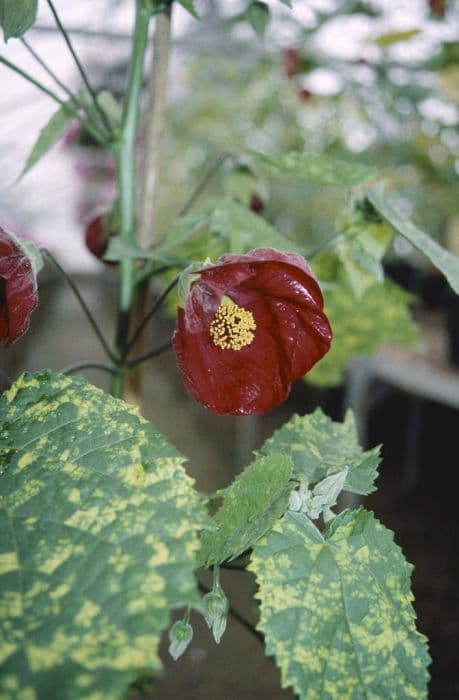
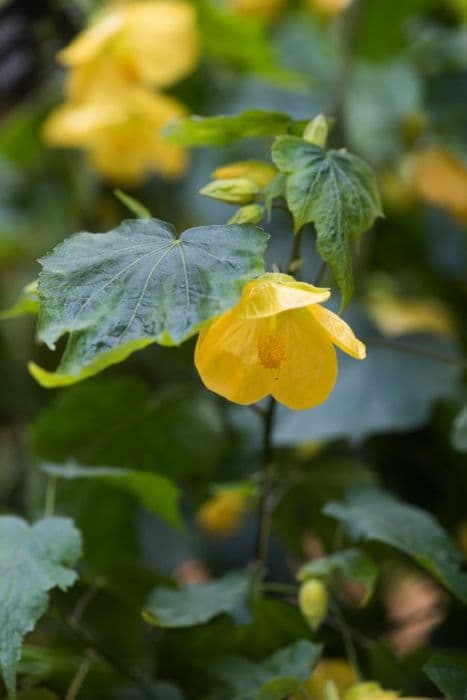
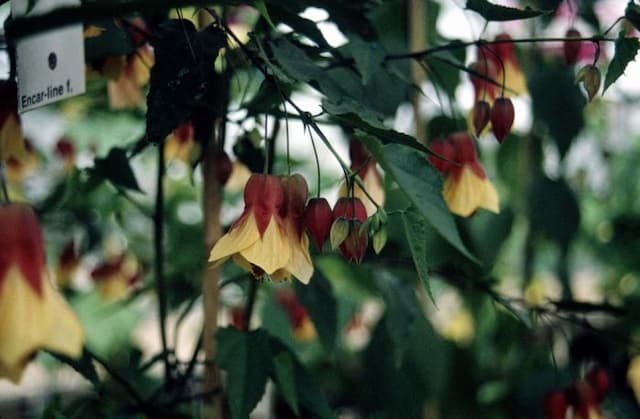
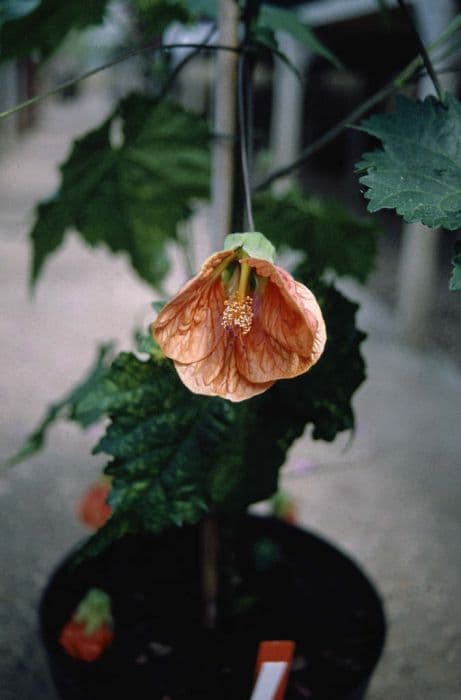
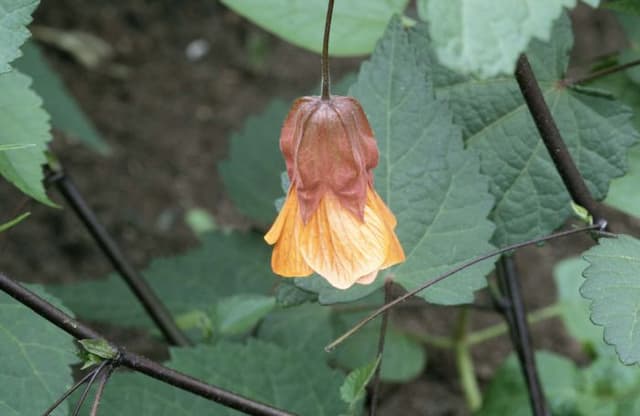

![Abutilon [Yellow Trumpet]](/_next/image?url=https%3A%2F%2Fplants-admin.emdemapps.com%2Fimages%2Fplants%2F%2Fimages%2F604b5caa8b4fb.png&w=640&q=75)

